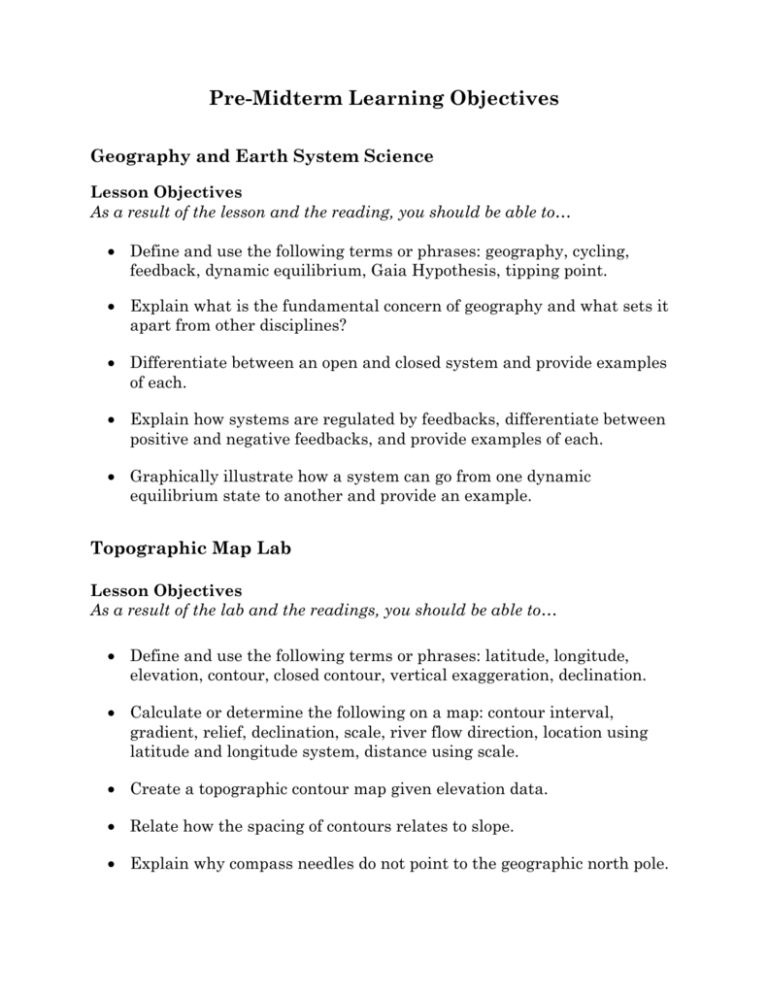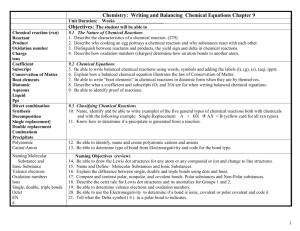learning objectives – Pre
advertisement

Pre-Midterm Learning Objectives Geography and Earth System Science Lesson Objectives As a result of the lesson and the reading, you should be able to… Define and use the following terms or phrases: geography, cycling, feedback, dynamic equilibrium, Gaia Hypothesis, tipping point. Explain what is the fundamental concern of geography and what sets it apart from other disciplines? Differentiate between an open and closed system and provide examples of each. Explain how systems are regulated by feedbacks, differentiate between positive and negative feedbacks, and provide examples of each. Graphically illustrate how a system can go from one dynamic equilibrium state to another and provide an example. Topographic Map Lab Lesson Objectives As a result of the lab and the readings, you should be able to… Define and use the following terms or phrases: latitude, longitude, elevation, contour, closed contour, vertical exaggeration, declination. Calculate or determine the following on a map: contour interval, gradient, relief, declination, scale, river flow direction, location using latitude and longitude system, distance using scale. Create a topographic contour map given elevation data. Relate how the spacing of contours relates to slope. Explain why compass needles do not point to the geographic north pole. Earth’s Heat Budget, Atmospheric Circulation, and Biomes Lesson Objectives As a result of the lesson and the reading, you should be able to… Define the following terms or phrases: Wavelength, ITCZ, Pressure Gradient, Coriolis Force Differentiate between: - Heat and Temperature Ultraviolet Radiation vs. Infrared Radiation High Atmospheric Pressure and Low Atmospheric Pressure Climate vs. Weather Explain how gasses in the atmosphere are selective absorbers? What do they absorb? How is this phenomenon selective? Explain why the Earth tends to be hottest at the equator. Explain why we have seasons, variable day length throughout the year, and why it is hottest in the northern hemisphere during our summer. Identify the latitude where the sun is directly overhead on the Northern Hemisphere summer solstice. Relate barometric pressure and vertical air motion to earth surface heating. Discuss the effects of land on atmospheric circulation and the position of the ITCZ. Relate how the Coriolis Effect deflects fluid flow in both the northern and southern hemispheres. Explain the generation of the trade winds and the prevailing westerlies. Explain the relationship the between the six-band wind model and the distribution of biomes on the planet. Properties of Water and the Hydrologic Cycle Lesson Objectives As a result of the reading and lecture, you should be able to… Define the following terms or phrases: heat capacity, latent heat of fusion, latent heat of vaporization, covalent bond, ionic bond, polar molecule; evaporation, transpiration, condensation, evapotranspiration, percolation, runoff, groundwater, aquifer, water table, reservoir, flux, equilibrium; residence time; relative humidity. Recreate a conceptual model of the Hydrologic Cycle. Identify 5 anomalous properties of water Explain why water molecules are polar molecules. Differentiate between covalent bonds and ionic bonds in molecules. Explain the ability of water to dissolve and separate ions. Relate why ice floats and why it is important. Relate how water moderates temperature extremes on land and sea. Explain how hydrogen bonds form in water and assess its importance. Check out - http://www.savingwater.org/waterconnection/cycle1.htm The Properties of Motion Lab - Lesson Objectives The Coriolis Effect: A Rotating Sphere, Air Circulation, and Coriolis Deflection Be able to address the following questions: What is the importance of the Coriolis Effect? What causes the Coriolis Effect? How does it impact air circulation? What are the dominant air currents (prevailing winds) on the planet? Pressure Gradients and 3D Circulation Around High and Low Atmospheric Pressure Cells Be able to address the following questions: What is a pressure gradient? What constitutes high atmospheric pressure? What constitutes low atmospheric pressure? How is pressure gradient related to atmospheric pressure systems? How do atmospheric pressure systems and pressure gradients drive atmospheric circulation? The Hydrologic Cycle: A Model of Reservoirs, Fluxes, and Residence Time Be able to address the following questions: What drives the hydrologic Cycle? What is the difference between a reservoir and a flux? What is the importance of residence time and how does it vary from reservoir to reservoir? Are the fluxes of the hydrologic cycle fixed? How is the hydrologic cycle changing over time? Are there imbalances in the hydrologic cycle? What is the relevance of the hydrologic cycle? The Anomalous Heat Properties of Water: Heat Capacity, Sensible Heat, and Latent Heat Be able to address the following questions: What is the difference between sensible and latent heat? What is heat capacity? What is unusual about the heat capacity of water? How does the heat capacity of water change as it goes from ice to liquid? What is the latent heat of fusion and what is important about it? What is the latent heat of vaporization and what is important about it? What are some of the impacts of the anomalous heat capacity characteristics of water on climate and weather? The Attractive Water Molecule: Covalent Bonding, Polar Properties, and Hydrogen Bonding Be able to address the following questions: How does water form a covalent bond? What are the characteristics of covalent bonds? Why does the covalent bond of oxygen to two hydrogens make the water molecule polar? What does it matter that the water molecule is polar? What are hydrogen bonds and why do they matter? The Solvent Properties of Water: Ionic Bonding and the Power of the Polar Water Molecule Be able to address the following questions: What makes the bond between sodium and chlorine an ionic bond? What characterizes ionic bonds? How are they different than covalent bonds? What happens to salt (NaCL) when dumped in water? What is it about water that makes it so effective at dissolving substances like salt?








